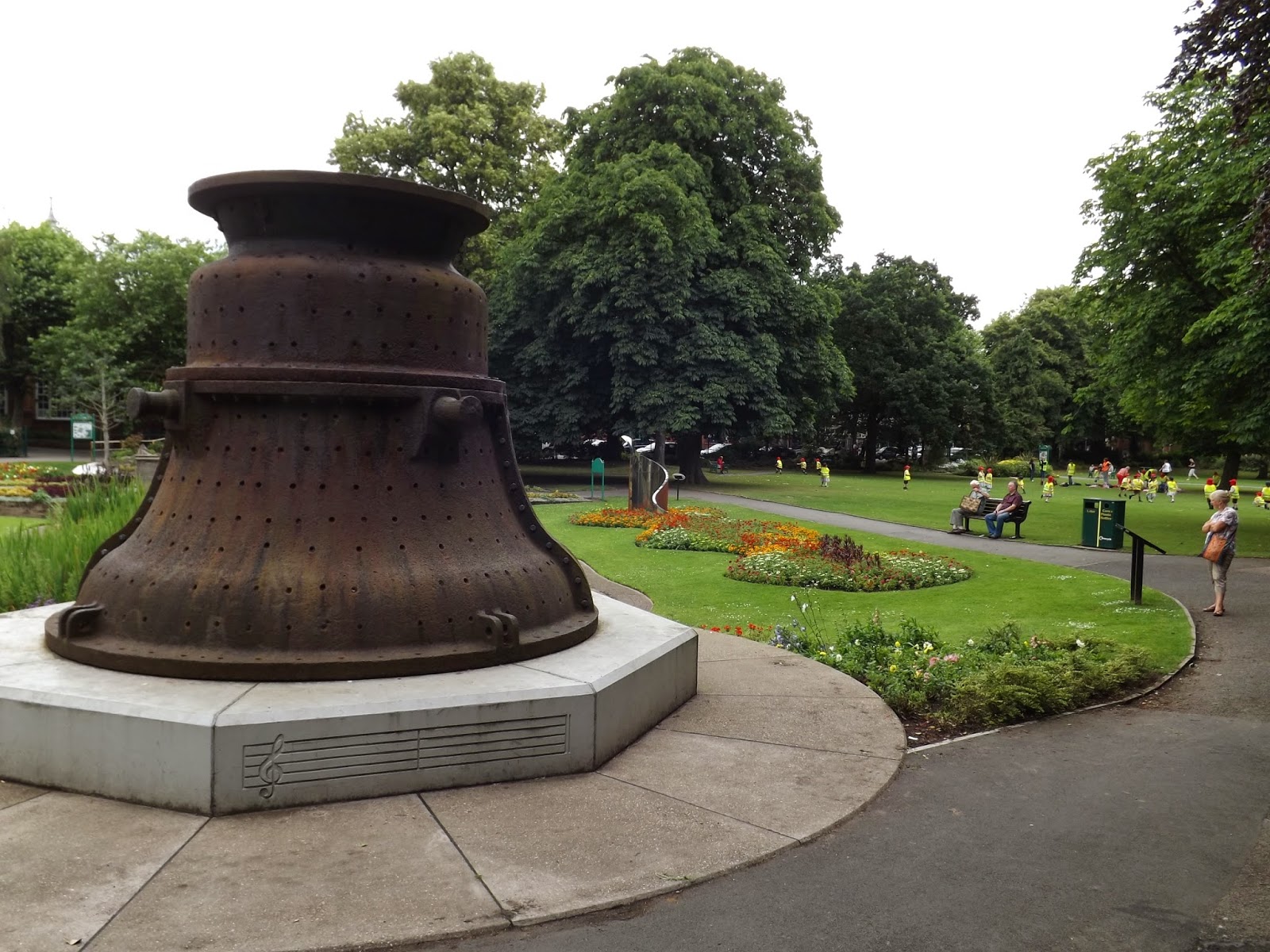Loughborough was basically built up on the making of lace and stockings following the invention of the knitting machine but we saw very little evidence of it and today seemed to be dedicated to bells. We were outside Taylor's Bell Foundry at just after 1000. We had to go to the office reception to get them to open up the museum and a few minutes later there were six of us. Whilst waiting we had a very interesting conversation with the Bell's advisor to the Coventry Diocese. We learned that our local church had a peel of 8 Taylor's Bells and that last week some new bells for Roos Church, near to us, were cast. The Carillon at the Guild Hall in Hull has just been finished of and opened and the bells were cast by Taylor's. (paid fore by a benefactor). The company started in the 14th century and has been owned by the Taylors from 1784 and moved to Loughborough in 1839. The foundry is the largest purpose built bell foundry in the world.
The Taylor's bell foundry in Loughborough with the campanile of twelve bells on the right of the photo. They were installed to be an advert for the company.
We first watched a very interesting film about the practice of creating a bell. There is many skills involved with casting, lathe work, leather, joinery and just about everything else you can think of. The work force of twenty double up jobs too. The bells are made of approximately 80% copper and 20% tin. The moulds are made using special loam mixed with goat hair, horse manure and nails for larger bells!
I noticed these bells built by Taylors for Trinity House in Hull that were created to fit in sound bells so that when the buoy bobbed about in the waves the bell would sound to warn of their position in fog.
There was an interesting museum and one of the areas showed the old furnaces and had several examples that demonstrated the the principles of five tone principle that gives the Taylor's bells a very distinctive sound. We then went up to the viewing gallery of the foundry floor. The floor of the foundry is 14 ft of sand as when they cast the bell they sink the moulds into the sand to contain any shattering, give a good working height and to allow the casting to cool more slowly.
The foundry floor at Taylor's. At the top right is a man making up a mould for a bell. The bell shapes you can see are actually the inner and outer parts of standard bells.
The biggest bell ever cast in the UK was 'Great Paul'. The mould took four months to create and only four minutes to pour the casting. It was cast in November 1881 and was finally installed in the tower at St Paul's in May 1882. This was a bell that was made for St Paul's Cathedral in London. The finished bell weighed in at about 16.5 tons and was hauled to London over eleven days by two steam traction engines. It is inscribed with the Latin for 'Woe to me if I preach not the gospel' and 'John Taylor and Co Founders Loughborough MDCCCLXXXI'.
A funny thing is that despite this bell being called 'Great Paul' and 'Big Ben' etc all bells, like ships, are actually known as female!
The original mould for 'Great Paul' in Queen's Park Loughborough.
Our bell education continued with a visit to the War Memorial in Queen's Park. The town had decided to build a Carillon as a fitting memorial to these lost in WWI. The whole of it was supplied and built by local companies, including the 47 bells made by Taylor's. On Thursday's and Sunday's there is a recital of music played for them. The bells are played on a piano type keyboard but you have to strike the keys with you fists to ensure that the pressure is transferred by the wires to the bells above.
The Loughborough War Memorial Carillon in Queen's Park.
Some of the 47 bells in the tower. All were paid for by companies and individuals to honour those lost and some for the safe return of individuals.
The Tower also houses two or three floors of a military museum that, though small, was very interesting and the guides were very interesting too. You could climb up to the balcony of the tower and gained lovely views of the surrounding area
Queen's Park from the Carillon Tower with the bandstand. The park is a regular winner of Britain in Bloom.
Also in the park is the Charnwood museum which is built in the the old swimming pool that closed in 1975. The water was emptied every day and filtered. When it opened in Victorian times it meant that the ladies of the town paid 2d to use the pool in the morning and others 1d in the morning and in the evening 1/2d the children were allowed in as by then it was pretty mucky water!
The market was very busy and there was plenty to see and was well worth a look round. All in all we have had a grand day in Loughborough and although a town not full of great building the bells made up for it as you wont get them anywhere else.







No comments:
Post a Comment